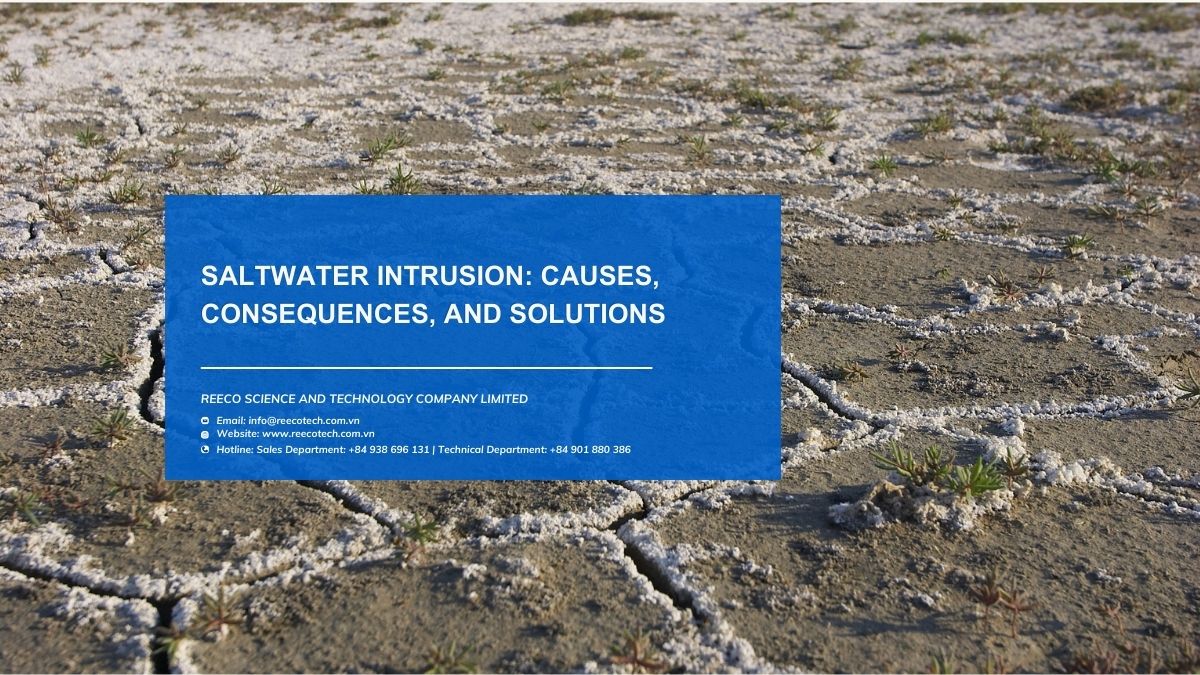Saltwater intrusion in Vietnam is becoming increasingly severe and urgent. This causes many problems related to the shortage of freshwater for domestic use, irrigation, and agricultural production. However, many people are still subjective, unintentionally accelerating the rate of saltwater intrusion significantly.

What is saltwater intrusion?
Saltwater intrusion, also known as soil salinization, occurs when the salt content in the soil exceeds acceptable levels due to seawater intrusion into the land. This often happens during high tides, sea-level rise, or when freshwater sources are depleted. Seawater carries dissolved salts, and when they are retained by the soil structure, saltwater intrusion occurs.
Additionally, saltwater intrusion is the process of replacing freshwater in coastal aquifers with saltwater due to the movement of the saltwater body into the freshwater body. Simply put, saltwater intrusion is the accumulation of excessive dissolved salts in the soil.

Causes of Saltwater Intrusion
Saltwater intrusion occurs when seawater moves into freshwater areas, especially during dry seasons when the amount of freshwater from rivers is insufficient to balance and push the saltwater back to the sea. The main causes of saltwater intrusion include:
-
- Climate Change and Global Warming: Global warming is increasing temperatures and sea levels. These changes affect rainfall and the rate of groundwater recharge, leading to increased saltwater intrusion.
Human Activities and Economic Development: Changes in river and stream flow patterns due to human activities, combined with increased flooding and riverbank erosion, have significantly reduced freshwater flow, contributing to saltwater intrusion. - Groundwater Overexploitation: Excessive groundwater extraction for domestic and economic purposes, without adequate replenishment, has depleted water sources and increased the risk of saltwater intrusion.
- Impact of Human Activities: Activities such as agricultural land development, deforestation, the construction of extensive irrigation systems, and the use of chemical fertilizers have altered soil structure and affected groundwater levels, contributing to the worsening of saltwater intrusion.
- Climate Change and Global Warming: Global warming is increasing temperatures and sea levels. These changes affect rainfall and the rate of groundwater recharge, leading to increased saltwater intrusion.
=> Learn: Monitoring saltwater intrusion in the Mekong Delta

What are the impacts of saltwater intrusion?
Saltwater intrusion causes severe damage to both daily life and economic activities. Specifically:
-
- Freshwater shortage: People cannot use saltwater for daily activities such as bathing, cleaning, and laundry, as saltwater is highly corrosive and damages water systems and storage containers. Direct contact with saltwater can cause severe skin irritation. The lack of freshwater also significantly affects crop irrigation, leading to stagnation in agricultural production.
- Impact on crops: Salt-contaminated soil negatively affects the growth and development of crops, making them unable to adapt and leading to mass death. Using saltwater for irrigation can cause salt shock, resulting in leaf, flower, and fruit drop and potentially killing the plants.
- Damage to aquaculture: Saltwater intrusion also severely damages aquaculture, significantly impacting the economy of households and localities.
- Impact on hygiene and health: The lack of clean water leads to poor sanitation conditions, increasing the risk of outbreaks of dengue fever and hand, foot, and mouth disease.
- Decreased soil quality: Saltwater destroys soil structure, reduces root growth, decreases water infiltration and drainage in the soil, and causes a lack of oxygen for root development.
- Increased demand for freshwater: The increased demand for freshwater during the dry season reduces groundwater sources and increases the risk of saltwater intrusion.

Some Current Solutions to Combat Saltwater Intrusion
To effectively address the issue of saltwater intrusion, a series of synchronized and timely solutions must be implemented:
Continuous Monitoring and Construction of Saltwater Barriers
Environmental agencies need to regularly monitor and control salt concentrations in water and soil, particularly in coastal areas and waterworks. Monitoring results should be updated continuously, and residents should be advised to prepare for preventive measures and respond promptly. To combat saltwater intrusion, it is necessary to build water systems, store freshwater, and prevent seawater intrusion by constructing dams and dikes in coastal areas. In particular, the construction of sea dikes and river dikes along the East Sea and West Sea is essential to respond to sea-level rise.
Installation of Saltwater Filtration Systems
In addition to storing and conserving water, people should install saltwater filtration systems to ensure a reliable source of water for domestic use and irrigation. Saltwater filtration systems can process dissolved salt components in water, providing water with suitable levels of sweetness. Filtered water can be used for direct drinking or for irrigating crops with low salt tolerance.

Saltwater intrusion control for crops and aquaculture, cultivating aquatic species
It’s essential to apply salt-resistant measures for crops, such as maintaining soil moisture and preventing water evaporation by mulching with straw at the base. Planting seasonal crops with high salt tolerance is recommended. For aquaculture, farmers should monitor and track salinity levels in the farming environment to determine the appropriate start and end times for cultivation based on the saltwater intrusion situation. Additionally, careful care is needed to minimize damage caused by drought, and people should be advised to adjust their species composition accordingly.
Implementing a saltwater intrusion monitoring system
To enhance the ability to respond to saltwater intrusion, it is necessary to establish a monitoring system in key areas. This system provides accurate data on the level of saltwater intrusion, helping to effectively adjust prevention measures. At the same time, the collected information supports the development of long-term response plans, protecting freshwater sources and agricultural and aquaculture production activities.
=> Lear more: Monitoring station warns of saltwater intrusion

Water Storage and Conservation
Industrial facilities and households should maximize the conservation of available freshwater and implement water reuse for various purposes. Freshwater should be collected from rainwater sources and stored properly to prevent evaporation during the dry season. This helps ensure a sustainable water supply for domestic use and irrigation.
